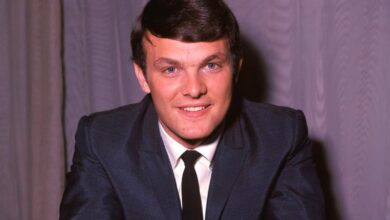Jelly Roll’s “Save Me” Finds New Life Through Kelly Clarkson’s Stunning Cover, Bridging Genres and Stirring Deep Emotion
When Kelly Clarkson took the stage to perform Jelly Roll’s emotionally raw ballad “Save Me” in 2024, few could have anticipated the cultural moment it would become. Originally released by Jelly Roll in 2020, the song was already hailed as a striking departure from his earlier work—a haunting plea for redemption that blended country, soul, and rock in a way that defied categorization. But when Clarkson, known for her powerhouse voice and emotional nuance, chose to cover the song live on national television, it reignited widespread interest in Jelly Roll’s career and brought the track to a new peak of resonance. For Jelly Roll, watching Clarkson pour her heart into the lyrics was an overwhelming moment—so powerful, in fact, that he broke down in tears while publicly sharing what it meant to him.
Jelly Roll, born Jason DeFord in Nashville, Tennessee, had already cultivated a loyal following through his gritty, autobiographical approach to songwriting. Rising from a turbulent past that included addiction, incarceration, and street life, he began carving his place in the music world by self-releasing mixtapes that combined hip-hop beats with Southern storytelling. While his early catalog leaned heavily into rap, it was his gradual shift toward country-infused ballads and personal lyricism that earned him mainstream recognition. “Save Me” became a turning point—an anthem of vulnerability from a man whose gravelly voice held the weight of hard-earned wisdom.
The origin of “Save Me” is as unvarnished as the lyrics themselves. Jelly Roll wrote the song during a period of deep introspection, grappling with the demons of addiction and the longing for a second chance. Collaborating with fellow Nashville songwriter David Ray Stevens, he sought to capture a moment of despair in its purest form. The song wasn’t written for radio—it was created out of necessity, a raw confession dressed in simple chords and gut-wrenching honesty. Jelly Roll has spoken openly about how the track helped him process the emotional fallout of his past and find purpose in his pain.
The original recording was produced with minimal instrumentation—just acoustic guitar, piano, and Jelly Roll’s aching voice, foregrounding the song’s lyrical urgency. The sparse arrangement allowed every word to breathe, making listeners feel as if they were sitting in the same room with the artist, sharing his confession. When Clarkson took on the song in 2024, she honored that intimacy while elevating it with her own emotional dynamism. Accompanied by a stripped-down piano, her rendition maintained the soul of the original while highlighting the song’s melodic depth and universal themes of regret and redemption.
Upon release, “Save Me” didn’t initially dominate charts in the way that Jelly Roll’s later singles would. But its digital success and viral acoustic performance videos earned it cult status among fans. By the time Kelly Clarkson’s version aired, the song had already been streamed over 100 million times, and the renewed attention catapulted it back into the iTunes Top 10 within hours. Clarkson’s cover received standing ovations from live audiences and critical praise from major outlets, leading to an official duet version between the two artists released later that month.
Culturally, Clarkson’s cover marked an important moment in genre fluidity—a pop powerhouse lending her voice to a modern country ballad with roots in Southern rock and hip-hop. It challenged preconceived notions about what “country” music could be, especially in an era when genre lines are becoming increasingly blurred. Clarkson’s embrace of “Save Me” sent a powerful message: that authenticity and emotional truth transcend musical boundaries.
For Jelly Roll, the performance was more than a career milestone—it was a moment of profound validation. Having spent much of his life as an outsider in the music industry, the recognition from an artist of Clarkson’s stature was deeply moving. In interviews, he described how he wept while watching the performance, stunned that someone he admired had chosen his story to tell. The duet version not only expanded his audience but also led to new television appearances and festival invitations across both country and pop circuits.
“Save Me” went on to inspire other artists to strip down their productions and return to storytelling as the heartbeat of music. It sparked a wave of acoustic covers and prompted conversations around mental health, addiction recovery, and emotional transparency in songwriting. Its influence could be felt in unexpected places—from church choirs to TikTok creators, each adding their own voice to the growing chorus of people finding solace in the song’s message.
Over the following months, several prominent musicians offered their interpretations of “Save Me,” including Noah Kahan, Lainey Wilson, and Lewis Capaldi. Each brought something new while preserving the song’s original ache. Yet none resonated as deeply as Clarkson’s performance, which Jelly Roll himself called “the most powerful version I’ve ever heard.”
At the time of Clarkson’s cover, Jelly Roll was also celebrating personal milestones—sobriety anniversaries, philanthropic outreach to incarcerated youth, and his daughter’s high school graduation. “Save Me” became a symbolic anthem of his transformation: from inmate to inspiration, from struggling artist to Grammy contender. It cemented his place as one of the most compelling voices in modern American music.
The legacy of “Save Me” only continues to grow. It has been added to countless “Greatest Songs of the 2020s” lists and remains a mainstay on country and rock radio stations alike. For many, it’s not just a song—it’s a lifeline. Its inclusion in Kelly Clarkson’s live set introduced it to an entirely new demographic, proving that a deeply personal story can have universal impact.
The song’s blend of emotional storytelling and genre-defying style has influenced a new generation of singer-songwriters unafraid to wear their scars on their sleeves. Whether in stripped-down acoustic sets or full-stage anthems, its blueprint can be heard in countless tracks that followed.
In the years to come, “Save Me” will likely be remembered not just as a turning point for Jelly Roll, but as a cultural moment when two powerhouse voices—one gritty and weathered, the other soaring and polished—came together to remind listeners of the healing power of music. What began as a personal cry for help became a shared experience, echoing in the hearts of millions.



